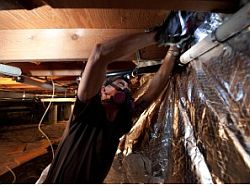 We get asked where is the Plumbing, Electrical and A/C access on my mobile home everyday at UnderHome Armor. The plumbing pipes, electrical systems, and air conditioning (AC) access is usually beneath mobile homes. This can be a challenge for homeowners, so we’d like to explain these essential systems under your mobile or manufactured home, of how plumbing pipes, electrical lines, and AC units are installed and function in mobile homes and Manufactured homes.
We get asked where is the Plumbing, Electrical and A/C access on my mobile home everyday at UnderHome Armor. The plumbing pipes, electrical systems, and air conditioning (AC) access is usually beneath mobile homes. This can be a challenge for homeowners, so we’d like to explain these essential systems under your mobile or manufactured home, of how plumbing pipes, electrical lines, and AC units are installed and function in mobile homes and Manufactured homes.
Mobile Home Plumbing
- Mobile Home Plumbing Pipes: Plumbing systems in mobile homes are designed to deliver water and remove waste efficiently. They consist of supply lines, drain lines, vents, and various fixtures. The plumbing pipes in mobile homes are typically made of either polyvinyl chloride (PVC) or cross-linked polyethylene (PEX).
- The Underbelly or vapor barrier: is accessible through removable panels, allowing plumbers to reach the pipes. The underbelly is typically enclosed with a weather-resistant material called a mobile home vapor barrier or underbelly.
- Mobile Home Water Supply: The main water supply line is connected to the municipal water source or a well. From there, the water is distributed throughout the mobile home using a series of smaller pipes. The supply lines are typically routed through the walls or floor, with insulation to prevent freezing in colder climates.
- Mobile Home Drainage System: The drain lines are responsible for carrying wastewater away from fixtures like sinks, toilets, and showers. These pipes are connected to the main sewer or septic system. Proper slope and venting are crucial to ensure the efficient flow of waste and prevent sewer gas from entering the mobile home.
- Mobile Home Fixtures and Connections: Plumbing fixtures such as faucets, toilets, and showers are connected to the supply and drain lines. These connections involve fittings, valves, and traps to regulate water flow and prevent leaks.
Mobile Home Electrical Systems:
- Mobile Home Electrical systems in a mobile home are similar to that of a conventional house, consisting of a main electrical panel, circuits, wiring, outlets, and switches. Here’s a breakdown of the electrical installation process:
- Main Electrical Service: The mobile home is connected to the main electrical service through a meter base, which measures the electricity consumption. The service entrance cable carries power from the utility pole or underground source to the main electrical panel inside the home.
- Main Electrical Panel: The main electrical panel houses circuit breakers or fuses, which distribute electricity to various circuits throughout the mobile home. Each circuit supplies power to specific areas or appliances.
- Wiring and Outlets: Copper wiring is commonly used in mobile homes to carry electrical currents. The wiring is routed through the walls and ceilings, connecting outlets and switches along the way. Wiring must comply with local electrical codes to ensure safety and prevent overloading.
- Grounding and Bonding: Mobile homes require proper grounding and bonding to protect occupants from electrical shocks. This involves connecting the electrical system to the grounding electrode system, typically through a ground rod driven into the earth.
Mobile Home Air Conditioning (A/C)
Air conditioning is essential for maintaining a comfortable living environment in mobile homes, especially during hot summer months. AC installation and maintenance on mobile homes is similar to conventional homes.
- Choosing an AC Unit: Mobile homes can accommodate various types of AC units, including window units, through-the-wall units, or central air conditioning systems. The choice depends on the mobile home’s design, size, and cooling requirements.
- AC Ductwork: In mobile homes, AC ductwork is often installed underneath the home or within the walls and ceilings. Flexible ducts made of materials like insulated foil or plastic are commonly used. The ducts distribute cool air from the AC unit to different rooms, ensuring proper airflow.
- Ventilation: Adequate ventilation is essential for the AC system to function efficiently. Ventilation ducts allow for the exchange of air, removing stale indoor air and introducing fresh air from outside. Ventilation helps regulate humidity levels and improve air quality.
- Maintenance: Regular maintenance is crucial to keep the AC system in optimal condition. This includes cleaning or replacing air filters, checking refrigerant levels, and ensuring proper airflow through the ductwork.
Understanding the plumbing-electrical-and-a/c in mobile-home systems in mobile homes is essential for homeowners and renters. With the knowledge of how these systems are installed and function, individuals can better troubleshoot issues, perform maintenance, and make informed decisions regarding upgrades or repairs. By considering the intricacies of plumbing pipes, electrical lines, and AC units in mobile homes, you can ensure a safe, comfortable, and functional living environment. UnderHome Armor can help you to maintain your mobile home, give us a call for a Free Consultation and estimate.